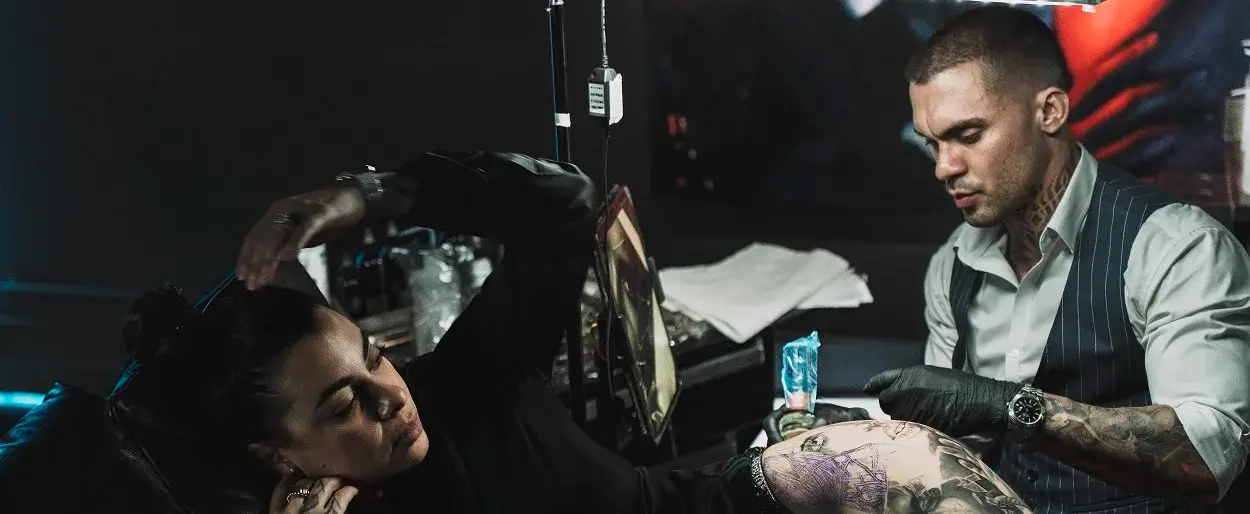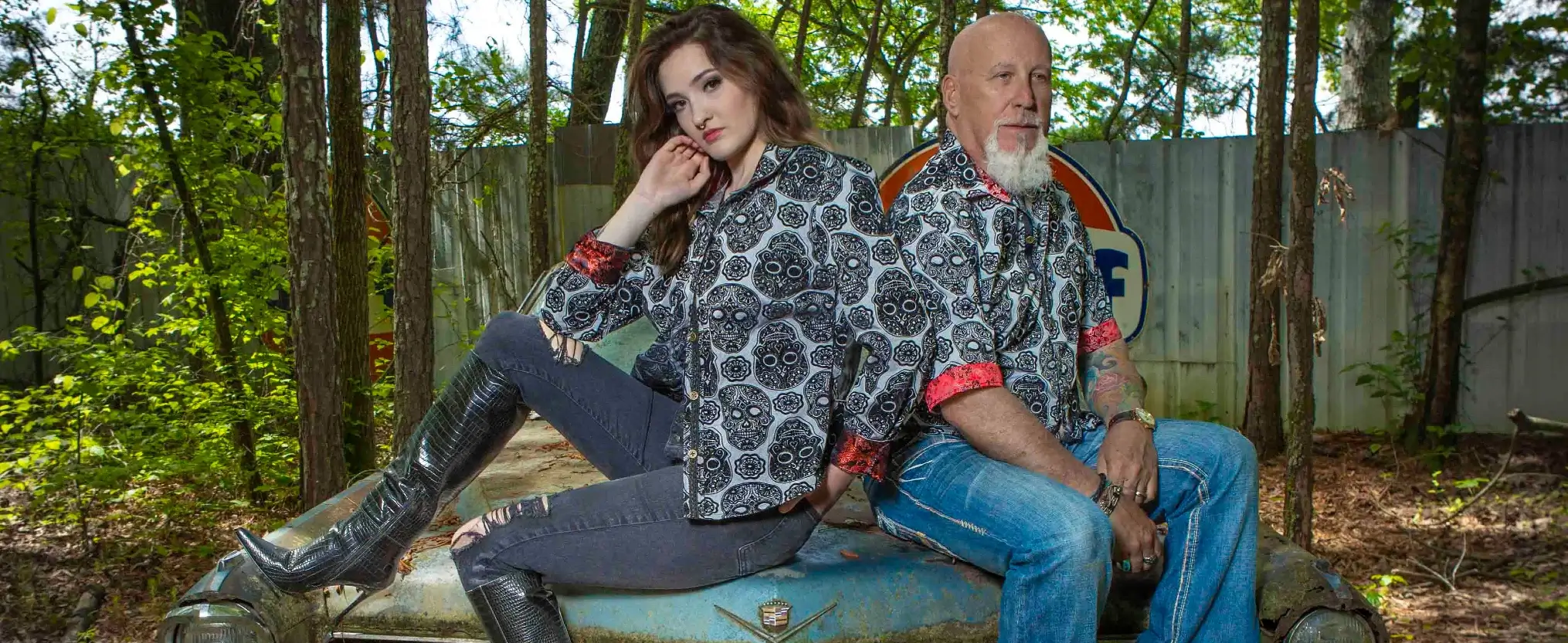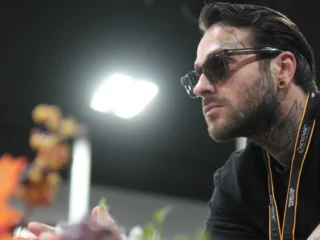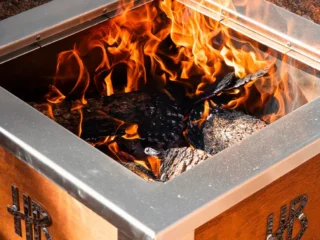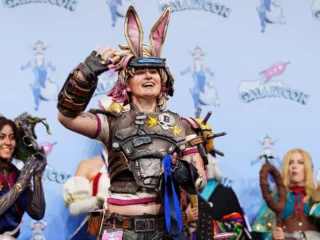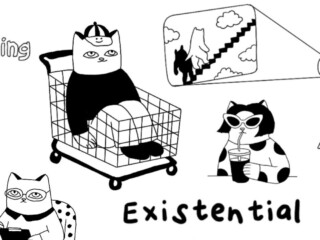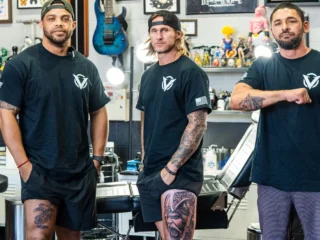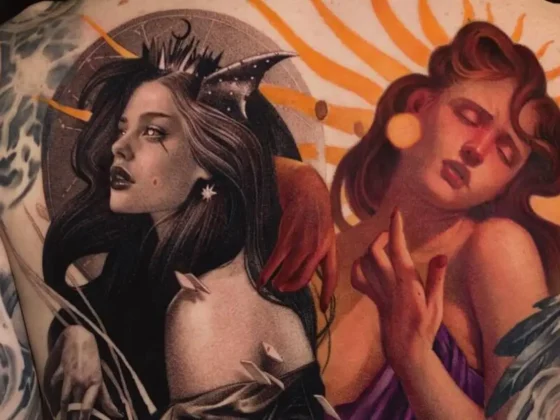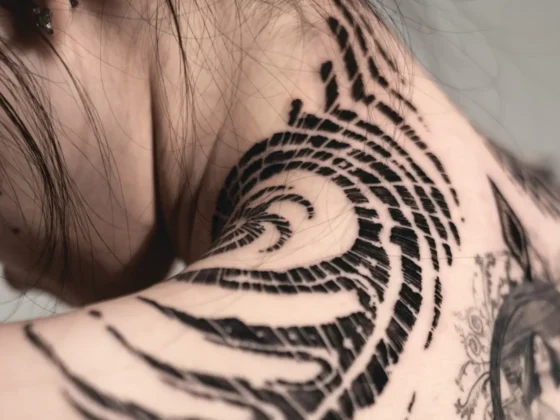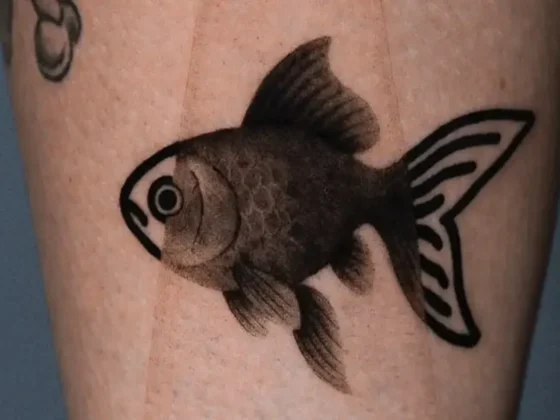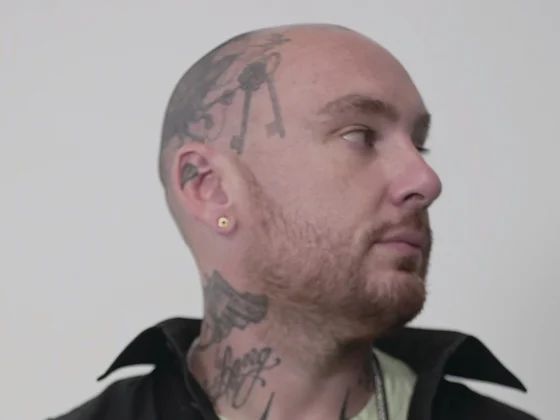Inked Mag Staff
September 21st, 2022
Outside the Box
On canvas or on skin, creativity runs in Cleo Kinnaman’s DNA
Interview by Dominic Ciambrone
Photos by Dominic Ciambrone and Bryam Villacres
Styled by Dominic Ciambrone
Style Assist: Christian Ferretti
Jewelry by Good Art
It’s impossible to pin a label on Cleo Kinnaman.
Kinnaman is a tattoo artist whose soft black-and-grey realism has been sought out by clients all over the world. She’s an artist who uses mixed media to create a surrealistic take on portraiture that is distinctly her own. She’s the creative director of Mistr, a Swedish brand focused on improving people’s wellbeing and quality of life.
The one binding agent that connects all of Kinnaman’s passions is storytelling. She is a master chronicler who developed the skill as a child to combat her fear that she would forget everything she experienced.
Dominic Ciambrone invited Kinnaman into his studio to discuss how she turned her childhood anxieties into the driving force behind her art, what fashion means and much more.
Where are you from?
My mother is Ethiopian. My dad is Greek and Swedish. I was born in Belgium. Then I moved to Germany, then Malaysia, and then Sweden. Now I’ve been in America for about eight years.
How long did you live in Sweden?
Let me count: also, like, eight, nine years. But it was for my formative years, so I feel very Swedish.
When did you start tattooing?
I started tattooing when I was 14 in Stockholm.
What inspired you to start tattooing?
I really didn’t like the way school was like in Sweden compared to what school was like in Malaysia and Germany. So I just needed to find a quick way to get out of there and make my own money and determine my own learning speed and money and travel and so on. So that was the initial thought, but then I actually started to love it.
So you’ve been tattooing for 13 years.
Nah, I’m older than that. Let’s see… about 16 years.
Do you remember the first thing you did with art as a kid? Like, with my kids, I would probably say crayons were first for them.
I would say it was the same as it is now, which is, I don’t really have a specific method or any rules as to what I start with and what I end with and what I do first and last. I typically have always loved all mediums. So when I paint now I do large-scale paintings. I use acrylic oils, charcoal, pencil, even plastic cotton, like, whatever I can find. And I use my hands a lot. I like to feel things. I like different textures. And when I see pictures of myself, when I was little, I’ve noticed it was always that way.

Have you ever built anything?
I’m not very handy [laughs]. No, I work with my hands in the way I glue things on and I layer things and I fold things. Yeah. Very intricate stuff.
Sounds handy to me. When did you start modeling?
I think I was a teenager, and I feel like it was in the same way that I got my tattoos. I got tattooed really quickly between the ages of 13 and 18, I pretty much got everything I have. I’ve been fully covered since I was 18.
I didn’t get tattooed til I was 18. Is it OK to get tattooed where you lived at 13?
I don’t think so [laughs].
You’re a rebel.
To be honest, I still don’t know why I look like this. I didn’t have an image or an inspiration. I don’t remember thinking of any person where it was like, “Oh, I want to look like that, I want to be tattooed.” I think I felt like an outcast and I was so deeply into tattooing that it just happened. I didn’t think about the attention it would give me or all that. Because frankly, at first I hated the attention. I like moving around and being able to kind of be unknown and discrete. But if you’re a girl and you’re a young girl and you start to get covered, quite the opposite effect happens.
Has it changed now or do you still feel like you get more attention because of the tattoos?
I definitely do, but it’s been good in a way because it’s forced me to be comfortable with people looking and talking to me. I used to be very standoffish. It creates a lot of bad energy in your life if people are walking up to you all day and you’re just like, “Ugh, don’t talk to me.” So I needed to learn how to be a little bit more open and kind and remember that the person who just asked me about my tattoos didn’t know there was a different person three seconds ago who asked me the same question. And that happens all day, especially if it’s summer and I’m by myself and I’m not wearing a lot of clothes… it happens all the time. So I’ve definitely learned to be more patient and compassionate because of it.
Where do you find your artistic inspiration when it comes?
When I was growing up, I moved around constantly. We moved around Europe and Asia and I was never really in one place [for long]. I’ve had a lot of amazing experiences and special experiences with people who I sometimes only meet for a day or a week or a month of my life, or a few years. As a kid, I got terrified I would forget them. So I started writing a lot. I love keeping a diary, taking pictures. I have pictures of friends and people I’ve met randomly since I was a little kid. I feel like a lot of experiences in people’s stories shape me. Nature as well—the way there’s different textures and things grow and even the way things smell.

What are some of your secrets to creating great portraiture? How do you capture a person’s essence properly?
If we’re talking about tattoos, I would say contrast and trying to find what stands out to you in an image is important. Key features, things like that. When it comes to painting, which I’m a little more passionate about nowadays, I do my version of a portrait. It’s not straight-up portraits, I try to capture people the way I see them. I have some portraits, for example, where someone doesn’t have a lot of confidence, but sometimes they are, to me, the most beautiful person. I’ll surround them with colors and things that reflect what it’s like looking at them and getting to know them through my lens. I do a little bit of surrealism in that way. Art is about showing your view of things and the way you see the world. I think it’s important to just focus on what you notice and what you gravitate towards.
When you were starting tattooing and doing art, when did you become fully confident in what you were doing?
Never [laughs].
It’s the same with me and shoes!
I’m never happy with anything I do, it’s never good enough. But I’ve learned not to beat myself up about it anymore, that’s the key difference.
I’m 36 and just realizing not to beat up myself because it’s never going to be good enough.
I also realize that the source who criticizes my stuff makes me see things that could have been better, it’s also the reason I can get better. It’s something I should be grateful for. I think the key for me is not beating myself up about it and realizing that’s a really incredible gift to have—to be able to see the flaws in what you do. People who are like, “Everything I do is fantastic,” how good are they really? Because they don’t see the things that could be better.
There’s definitely a flow to it, and it’s never perfect. When I started teaching I really pushed the idea of “trusting the process.” I had a journey of trying to be a perfect human. To make perfect art, be a perfect man, a perfect dad… and what I ended up doing was driving myself crazy trying to find this perfect thing that didn’t exist. So once I took a look at it and thought, “I’m perfectly imperfect.” I hated using the word “perfect,” but now I love it because it’s subjective. I can look at a shoe and, like, call out a stitch and always pick it apart…
Don’t you ever accidentally make mistakes and then when you continue that pattern it actually turns out to be something cool?
Sometimes they’re the best ones.
Sometimes even when I paint or even when I tattoo there are things… not things that are wrong, but things that I don’t think I wanna do. Something I do differently. Then I’m like, “That looks really good.” And I start seeing a pattern and I continue it.

We talked about it a little earlier, but how has your travel around the world inspired you artistically?
I think it impacted me a lot more subconsciously than I even realized. Naturally seeing so many different colors and the way things are constructed in different cities and the way people act and move and all these organic elements are so completely different. I think it shapes my artistic expression without me really even knowing it.
Let’s talk about fashion a little bit. What do you like about [your] clothing and shoes? Like, what is fashion to you?
I used to think it was way more superficial than I feel now, because it can completely change my mood or my attitude depending on how comfortable I am or how I feel in what I wear. To me, it’s super important.
It’s fun, right?
I remember being a young kid and getting matching stuff and dressing up because it made me comfortable. Maybe not in my skin, but in my clothes. Looking back on it there’s a part of it that felt superficial, but it’s an expression of who I was as a kid. Now it continues to evolve and now it’s fun.
What are some of your favorite sneakers?
I’m not gonna lie, I’m not a huge sneaker person. I like sneakers, but I feel like I wear boots more than anything.
How many sneakers do you have? I know you have a pair of mine…
I have probably, like, 15 sneakers.
…that you gave to what’s-her-name.
She’s borrowing them because she adores them.
Do you remember how we connected? It’s been a few years.
I honestly don’t remember. Do you remember?
I made shoes for Snow and then you hit me up.
Was it because I was painting Snow? I was doing a DNA painting of Snow. I remember reaching out.
I’m thinking about that painting we talked about with the butterflies in the background. We were talking about actually doing a pair of shoes like that with the mixed media, a pair of shoes would be amazing! When I bring people into my studio, it’s just really cool to show artistic people such as yourself inside my mind and how I’m thinking about things, because you only see so much from Instagram.
You’ve created such a beautiful space. And I love the community part of it. You know, I haven’t seen it in full swing, but everything seems exciting. I think it’s super important for people [to connect].

Editor's Picks
Bridging Classical Art and Modern Tattooing
Esteban Rodriguez brings the discipline of classical fine art to the living canvas of skin, creating hyper-realistic tattoos that merge technical mastery with emotional depth.
Show Your Ink Fashions Brings Custom Style to Tattoo Culture
Show Your Ink Fashions creates custom shirts designed to showcase your tattoos as wearable art, blending fashion with personal expression.
The Ultimate “Superman” Tattoo Roundup: Just in Time for Superman’s Return to Screens
With Superman’s big return to theaters, fans are revisiting some of the most iconic ink inspired by the Man of Steel.


